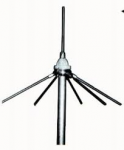Does the shape of a ground plane radial matter?
Modeling software deals with lengths maybe even diameter... Ham, commercial, marine antennas - dyi or purchase have tubular or wire radials....
I have a vhf antenna that has (and is the only fault in design) 3 radials maybe 3/8th in diameter.
My plan was to add more radials.. But because of set screws, where I would drill and tap 3 more radials, my plan changed to just widening the existing radials.
I eventually came to the conclusion I could get more width out of aluminum flat stock than wider aluminum tube.
1.25" width x .25" thickness on all three radials. And I could use the original tapped sockets with aluminum bolts to secure them.
I know it won't change the decoupling from the mast,,, but will it change anything, I'm not thinking of?
It's unity gain, so I don't think it will effect take off angle?
It's not that crucial but now the thought is in my head... and now I'm curios .
Any thought's Please and Thank you
Modeling software deals with lengths maybe even diameter... Ham, commercial, marine antennas - dyi or purchase have tubular or wire radials....
I have a vhf antenna that has (and is the only fault in design) 3 radials maybe 3/8th in diameter.
My plan was to add more radials.. But because of set screws, where I would drill and tap 3 more radials, my plan changed to just widening the existing radials.
I eventually came to the conclusion I could get more width out of aluminum flat stock than wider aluminum tube.
1.25" width x .25" thickness on all three radials. And I could use the original tapped sockets with aluminum bolts to secure them.
I know it won't change the decoupling from the mast,,, but will it change anything, I'm not thinking of?
It's unity gain, so I don't think it will effect take off angle?
It's not that crucial but now the thought is in my head... and now I'm curios .
Any thought's Please and Thank you



